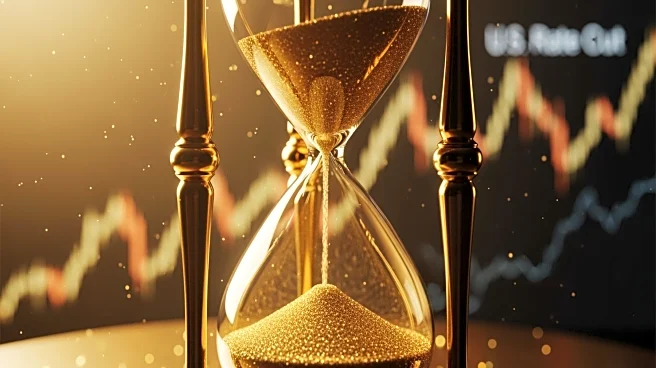What's Happening?
Gold prices have reached a three-week high, surpassing $4,200 per ounce, driven by investor optimism regarding a potential interest rate cut by the Federal Reserve in December. The surge follows the reopening
of the U.S. government after a 43-day shutdown, which delayed the release of economic data. Spot gold hit $4,215.49 per ounce, marking its highest level since October 21, before settling at $4,187.49. This year, gold has surged 60%, reaching a record $4,381.21 on October 20. Analysts suggest that the anticipated release of economic data could reveal a softer U.S. economic picture, justifying further rate cuts. Lower interest rates typically benefit gold, a non-yielding asset, during times of economic uncertainty.
Why It's Important?
The rise in gold prices reflects broader economic concerns, including potential currency debasement and U.S. debt issues. Investors are increasingly turning to gold as a safe-haven asset amid geopolitical tensions and structural economic worries. The metal's surge has been fueled by increased ETF inflows and central bank purchases, indicating a shift away from the U.S. dollar. This trend highlights growing anxiety about the U.S. fiscal outlook and the possibility of currency devaluation. The significant increase in gold prices, outpacing equities, has raised concerns about a potential bubble, with some analysts warning of speculative risks similar to those seen in AI-driven stock markets.
What's Next?
The Federal Reserve's next meeting could result in a 25 basis-point interest rate cut, as predicted by 80% of economists in a Reuters poll. This decision will be influenced by the forthcoming economic data, which may reveal job market weaknesses. Investors are closely monitoring these developments, as further rate cuts could continue to support gold prices. Additionally, the ongoing geopolitical and economic uncertainties may sustain demand for gold as a protective asset. However, there are concerns about whether gold prices can maintain their current levels or if a market correction is imminent.
Beyond the Headlines
The current rally in gold prices underscores a broader shift in investor sentiment, with traditional drivers like the dollar and real yields becoming less influential. This change reflects deeper structural concerns, such as currency debasement and U.S. debt, which could have long-term implications for global financial markets. The trend towards de-dollarization, evidenced by record central bank gold purchases, suggests a potential reconfiguration of international monetary systems. As investors seek alternatives to traditional assets, the role of gold as a hedge against inflation and economic instability may become increasingly prominent.












